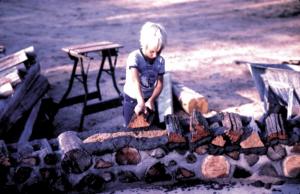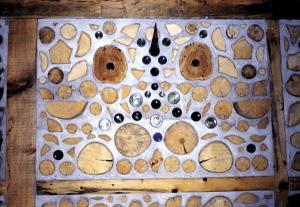2001 - Volume #25, Issue #4, Page #20
[ Sample Stories From This Issue | List of All Stories In This Issue | Print this story
| Read this issue]
Cordwood Construction: Cheap, Strong, And Energy Efficient
 |
 |
 |
A firm believer in avoiding debt as much as possible, the couple decided to build their own home with low-cost materials.
"We saw a photo of a cordwood building in the April 1974 issue of National Geographic. As soon as we saw the picture, it instantly made sense to us and we decided this was how we would build our house," Roy says.
They looked around for a cordwood home to inspect but they couldn't find one in their part of upstate New York.
They finally found some to look at not far away in Canada.
They built their first house, which they dubbed "Log End Cottage" over a couple of years, completing it in 1976. It took awhile because they wanted to get it right.
"Cordwood masonry has been used for thousands of years, but we couldn't find anything written on how to do it. It's sort of a folk skill, passed on from generation to generation," Roy says.
They asked a lot of questions, though, and have since become experts at it. They've written a number of do-it-yourself books and articles and they now run a school teaching cordwood construction and other low-cost and energy efficient building methods.
Roy says cordwood construction has several advantages over other building methods. "First, you can use logs that are undesirable for sawing into lumber or for log home construction," he says. Logs of any diameter can be combined together and split wood can be used as well. The logs can be arranged to make artistic patterns in the building wall, or just laid together with no pattern or planning.
He says wood for cordwood construction should be dry, but not too dry. If it's not dry enough, it shrinks away from the mortar, leaving a gap that has to be filled. "Too dry can be a worse problem, though," he explains. "If wood is too dry, it will soak up moisture during wet weather and may expand enough to crack the mortar."
You can make the walls any thickness you want. The Roys' cordwood home has 16-in. walls, but walls that are 2 ft. thick are common and they've even heard of people building 3-ft. walls."
Roy says a cordwood wall is much easier to build than a log wall, especially for one person working alone, since the logs are so much smaller.
The method they teach calls for 6 in. of insulation between 5-in. layers of mortar at the outer and inner ends of the logs. "This gives 16-in. walls an insulation value of about R19," he says.
He uses sawdust for insulation, adding that since the inner and outer layers of mortar aren't physically connected, the inner layer becomes a heat repository, making the building even more energy efficient.
He recommends a mortar mix made of nine parts sand, three parts soaked softwood sawdust (pine, hemlock, white cedar, etc.), three parts Type S lime, and two parts Portland cement, either Type I or Type II.
Adding the soaked sawdust retards the setting time of the mortar, so it dries with less shrinking and cracking. Roy says the sawdust must soak at least overnight. Using dry sawdust will cause the mortar to dry more rapidly, resulting in more cracking and shrinking. He adds that he has not been able to achieve good results from using hardwood sawdust, such as oak or maple.
Roy says cordwood masonry can be used for just about any type of building, adding that his home, office, sauna and other outbuildings are all constructed this way.
Contact: FARM SHOW Followup, Rob and Jaki Roy, Earthwood Building School, 336 Murtagh Hill Road, West Chazy, N.Y. 12992 (ph 518 493-7744; E-mail: robandjaki@yahoo.com; Website: www.cordwoodmasonry.com).

Click here to download page story appeared in.

Click here to read entire issue
To read the rest of this story, download this issue below or click here to register with your account number.




